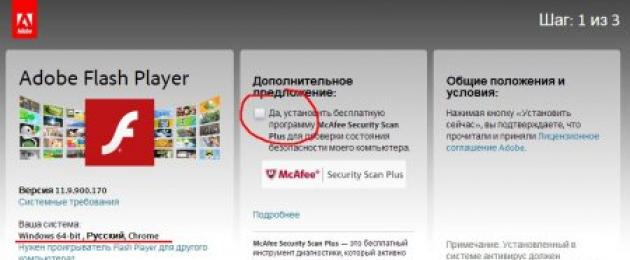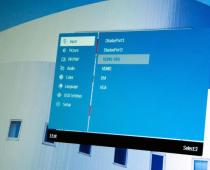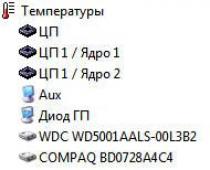Adobe Flash Player is the most widely used plugin for playing web content, even despite the introduction of its competitor, HTML5. You can install and activate it in any browser you use. In this article we will tell you how to install and configure a flash player in just a few steps.
Updating flash player to the latest version
Step 1.Download and install the latest version of Flash Player.
Step 2
Download the Adobe Flash System plugin. You will find a large yellow button that says “Install Now” (click it).
Note: Along with the flash player, Adobe also offers to download additional software. Usually this is McAfee antivirus. If you do not want to install it, uncheck the box under “Additional offer”.

Go to the directory where you downloaded the installation package. Double click to open the downloaded installer. This will start the installation process. Follow the onscreen instructions to complete the installation.

Note: It is recommended to close all browsers during installation, otherwise the changes will not take effect until you restart them.

Enable flash in your browser
In most browsers, the Flash player is automatically activated after installation, however, with some security settings, it may not be activated. In this case, it must be enabled manually.Open the browser you use most often.
Go to the "Tools" menu. And select “Extensions” or “Add-ons”.

Find the Adobe Flash Player or Shockwave flash plugin and check the “Enable Flash Player” checkbox.

Checking Flash Player
Step 1Restart your computer. You can do this manually by clicking the Reset button (not recommended) or find the appropriate option in the Windows Start menu.
Open your browser and load a page that uses Flash technology, such as the popular YouTube video resource. Try uploading a video. If it loads without any problems, you have successfully enabled Flash Player.
Setting up the Adobe Flash Player plugin
To configure the Flash player, use the local storage manager, which can be opened by going to the “Control Panel” and selecting “Flash Player”.
Local storage settings are used to manage permissions to use the plugin and store information.
Using local storage settings, you can allow or block websites from storing information through Flash Player, and you can set the amount of information stored. Websites can store browsing history, flash game statistics, and computer information.

To allow Internet resources to store data on the user’s computer, select the “Allow sites to store data on the computer” option.
To allow only certain websites to store data, select the "Ask before allowing new sites to store information on this computer" option.
To prevent all web resources from storing data on your PC, select the “Block all sites from saving information on this computer” option.
Note. When you select the last option, absolutely all local storage is deleted from your computer. Before this, you will see a request to confirm deleting local storage and setting a ban on data storage.
Many Internet surfers often encounter that videos do not play on the resources they visit, online flash games cannot be launched, the multimedia content of pages is displayed incorrectly, etc. The reason for this is a missing or deactivated Adobe Flash Player plugin. How to enable it in different browsers, and at the same time eliminate some problems with its operation? This will be discussed later in the article.
Why doesn't the Adobe Flash Player plugin work?
The plugin belongs to the category of add-ons that have almost a primary impact on the playback of multimedia content on web resources. In some browsers, its presence is assumed initially (Google Chrome); in other programs, the extension must be installed additionally.
However, even if this add-in is present on the system, it may not work correctly or may not function at all. The reasons usually cited are:
- incorrect installation or corruption of plugin files;
- accidental or intentional deactivation;
- lack of updates.
Let's leave for now the problems associated with the player's inoperability and its update, and focus on the issues of enabling it in the most popular browsers. It’s worth saying right away that activating the add-on in all programs without exception is done almost the same way (only the names of the menus and sections of the corresponding settings differ).
Adobe Flash Player: how to enable the plugin in the Google Chrome browser
Access to extensions in one of the most revered browsers called Google Chrome is carried out through the address bar, where, depending on the software version, two types of commands can be written: either chrome:plugins or about:plugins.

In the plug-ins window, find the Adobe Flash Player plugin and click on the “Enable” hyperlink located just below the name. You can also check the “Always Allow” box so that when opening the corresponding content on a web resource, the program does not constantly prompt the user to play the content.
Activating the extension in the Mozilla Firefox browser
As for the question of how to enable the Adobe Flash Player module in the Firefox browser, everything is simple.

Access to the corresponding add-ons is carried out in the menu, called up by pressing the button with three horizontal lines on the panel at the top right, where the add-ons icon is selected (this section can also be accessed by entering the about:addons command in the address bar). In a new window, select the plugins menu, where all available modules will be listed. We find the corresponding module. You can enable or use the Adobe Shockwave element using the drop-down menu field just to the right. Here you need to select the “Always on” option.
Enabling an add-on in the Opera browser
Now a few words about another popular browser called Opera. You can enable the Adobe Flash Player plugin through the main menu, which can be called up by clicking the button with the name of the browser located at the top left.

Here you select the line to go to the settings. In the new window on the left there is a section “Websites”. After accessing it, you need to find the block of plugins and use the hyperlink to disable some of them, which is located just below the control button. Again, this is where you look for the Adobe Flash Player add-on. How to enable the extension? Yes, exactly the same as in other browsers - just click on the corresponding control element (the “Enable” button).
Separately, it is worth saying that some sections may be missing in different versions of the browser, and sometimes access to setting up plugins can be accessed from other menus. But in general this does not affect the situation.
Update issues
We sorted out the inclusion. Please note that after activating the plugin in any browser, the browser program will need to be restarted. But what to do when the extension seems to have an active status (enabled), but the plugin itself does not work? The whole problem here is the lack of updates.
As a rule, during the initial installation of the player into the system, its own update tool is also integrated, which, if there is a constant connection to the Internet, monitors the release of new versions of the plug-in.

If the updater issues a notification that the update is ready for installation, it is better to immediately agree, go to the official website and download the latest release of the add-on. After this, however, you will have to install it manually, using the downloaded installation file.
But even here, not everything is as simple as it seems. The fact is that the installation process has practically nothing to do with the update, since the old version is not updated, but only the new one is installed, and often not even on top of the existing modification, but in parallel with it. This in turn can cause conflicts.
Therefore, before installing a new release, you should completely remove old versions. This can be done from the programs and components section present in the Control Panel, or you can use specialized utilities like iObit Uninstaller, the advantage of which is that they are able to remove both residual program files and the corresponding system registry keys that may remain after uninstallation core application components.
And only after this you can install the extension, and then make sure it works by checking the settings in the appropriate browsers.
Conclusion
That's it for the Adobe Flash Player plugin. I think it’s already clear how to turn it on. Browsers like Internet Explorer, Edge and programs created based on Google Yandex Browser, Amigo, etc. were not considered here). There are no fundamental differences in the methods for activating the Adobe Flash Player add-on. Basically, the differences relate only to menu names and the location of some controls. Otherwise, no user should have any problems.
As for updates, it is best to follow the recommendations given and remove all outdated modifications before installing the latest version. In addition, if for some reason it is impossible to download the plugin, you can download the distribution kit from the official website through proxy anonymizers on the Internet or change your location in the browser or geolocation settings manually.
5 / 5 ( 1 vote)
- For OS: Windows XP, 7, 8, 10
- Bit capacity: 32 bit, 64 bit
- Update date: 15.08.2019
- Developer: Google Inc
- Official site: google.com
Google Chrome is a web browser created by the famous Google corporation. It provides the user with instant, convenient and secure work on the Internet. The browser uses WebKit and Mozilla properties. Because of this, it provides greater stability, security and speed than other currently known analogues. At the same time, Google Chrome has a user-friendly and lightweight visual appearance.
Isolated Internet pages, which do not allow the program to crash, are considered by the developers to be one of the most important and worthy features of the browser. That is, if one of the pages freezes, all the others will continue to work. The program is also equipped with fairly high protection against malicious sites.
Chrome will turn surfing the Internet into a quick activity with minimal system resource consumption. Using a variety of extensions for Google Chrome will allow you to use only the program capabilities that a person actually needs.
Download Google Chrome for Windows
Some features and capabilities of Google Chrome
- Isolation of processes. Each window does its job separately from the other page. In case of problems or interruptions with one of the tabs, the problem will not affect the overall operation of the web browser;
- Internal task manager. The task manager is needed to monitor the browser's use of OS resources. If necessary, any activity can be terminated;
- Omnibox. The address and search bar are connected;
- High-performance JavaScript V8 processing engine;
- Accelerated loading of web pages (DNS Read Ahead);
- Built-in Adobe Flash Player plugin;
- "Incognita". The ability to view pages without further saving them in the browser history or search. Cookies are also deleted when the tab is closed;
- Auto translator. If you have opened a foreign website, the system recognizes the language and displays the translated data in the window;
- Safety. Google Chrome protects against malicious pages;
- Chrome has a simpler version - Google Chrome Portable;
- Synchronization. If you have a Google account, your data (including bookmarks, passwords and history) will be saved on all devices;
- Extensions. Additional functions and features of Chrome will make your work easier (themes and extensions in the Chrome Online Store);
- Multilingual adaptation. Chrome supports more than 40 languages. Their list includes Ukrainian, Serbian, Arabic, Belarusian, etc.;
- Available for Windows, macOS, Linux, Android, iOS and Chrome OS.
If your favorite Google Chrome browser suddenly began to behave incorrectly, due to an update, or it just got into his head, then it’s worth finding out the reason. In most cases, everything is resolved in five minutes. So, videos stop playing, online players refuse to work, and you keep getting the error “the following plugin has failed: Shockwave Flash”? It looks like Flash Player in Google Chrome is slow or missing.
Flash Player for Google Chrome
Adobe Flash Player is a common utility that is a player for Flash files. It has long become an indispensable module for playing multimedia content. Since the program is installed both in browsers and on a computer, it is able to play not only network, but also offline video content.
In order to play videos, animations, interactive presentations and flash games correctly and without lags through an Internet browser, you should add this program to your computer. The flash player plugin is suitable for Google Chrome and not only; all other browsers also need it for correct operation.
Typically, flash plugins are installed with the browser, but there are times when there is a need to additionally download the latest version of Flash Player for Google Chrome.
When they may occur:
- The browser does not function correctly with the built-in plugin.
- The new version of the browser has not yet been fully tested.
- The browser plugin lacks certain features that the full software has.
Download flash player for Google Chrome for free
You can download the latest version of Flash Player for Google Chrome from the link below for free. The utility is constantly updated, it is supplemented and corrected. The developers take into account all the features that appear in the latest versions of each browser.
What opportunities can you, as a user or developer, get if you download Adobe Flash Player:
Improved API for downloading files via the web interface.
The development of Flash games, synthesizers and audio visualizers will be a pleasure, since work with sound is highly optimized.
New text layout algorithm, improved system.
Downloading the software gives you the ability to process audio in real time using Pixel Bender, a new compiler that is integrated into the software.
Any Flash application or module has faster processing thanks to optimized GPU calculations and streamlined VideoRAM loading.
If you want to update flash player in google chrome, do it right now. Installation will not take much time.
How to update flash player in Google Chrome
As I wrote above, the chrome browser has a built-in flash plugin, which is updated along with web browser updates. But due to the fact that sometimes unexpected breakdowns occur, the built-in plugin may not function correctly. Thus, the video opens in all other browsers, which means the flash player downloaded to the computer works.
It is very easy to update it; to do this, follow the link above and click the “Download” button. The system will detect that you already have flash player installed and will simply update it.
But what to do with the google chrome browser, how to fix the crashing problem? To do this, you need to disable the built-in player and enable the external one that you downloaded and installed in Windows.
How to enable Flash Player in Google Chrome
In the address bar of the browser you need to enter: about:plugins and press the “Enter” key. A window will open with all installed plugins. At the top right, next to the word “More”, click on the plus sign to expand information on each plugin. Among all installed modules, you should find two flash players. It is very easy to distinguish which of them is built-in and which is external, just look at the installation path.
The next thing you need to do is disable the flash player, which is built-in in chrome, and “Enable” the external one. Next, close the tab and restart Google Chrome.

How to enable flash player in Google Chrome if the browser does not have it at all
There may be a situation where there is no flash player plugin in Google Chrome at all, this is possible due to the fact that fellow Google wants to abandon Flash altogether in favor of HTML5. As a result, the creators of the web browser decided to abandon support for the Netscape Plugin API. Namely, it is necessary for the installation and correct operation of many plugins, including Adobe Flash Player.

And what should you do in this case, should you really give up your favorite browser? In no case, you just need to enable NPAPI support back and use the necessary plugins.
We write in the browser line: chrome://flags/#enable-npapi

Click on the “Enable” button for NPAPI and restart Google Chrome.

As you can see from the picture, the flash player for Google Chrome is active again. By the way, don’t forget to check the box next to “Always run”. Otherwise, you will receive a notification “The Flash Player plugin requires permission to work” as soon as you want to watch the video. This is not an error, so there is no need to worry, because Google considers this technology to be outdated and therefore not supported, which is why it is trying to block it.
Fans of movies, music, and games cannot do without Flash Player in Yandex. Many resources for playing media content and graphics use this technology. It's a shame if Adobe Flash doesn't work. This problem needs to be fixed as soon as possible. Otherwise, the world of online entertainment will noticeably “dim” - all the resources of websites cannot be fully used.
If such an incident occurs in the Yandex browser on your PC, the plugin does not function, read this article. It describes in detail how to enable Flash player in the Yandex browser.
Standard browser settings
Enabling the plugin
If you see a message on sites stating that Adobe Flash is disabled or does not work (for example, in video frames), first check its connection in your web browser:
1. Launch Yandex. Open a new tab: click “plus” in the top bar.
2. In the address bar, type - browser://plugins. Press "Enter".

Note. To quickly switch to a tab, you can use the hint in the drop-down list.
3. In the Adobe Flash Player block, click “Enable” if the plugin is disabled.

Note. Additionally, you can enable the “Always run” add-on (check the box next to this command).

Flash enable control
If necessary, you can further configure Flash:
1. Click “three stripes” (“menu” button).

2. At the bottom of the list, click Show advanced settings.

3. In the Personal Information section, click Content Settings.

4. In the “Flash” block, select the operating mode for the plugin (enable for all sites, launch important content, global disable).

5. To selectively activate/disable for individual domains, use the “Manage Exceptions” button.

Enter the site address in the field below the list and assign an action (“Allow”, “Block”).
Advice! You can edit predefined rules in exceptions for trusted web resources: change the action, delete.
Disabling the Flash filter
Sometimes Flash Player does not work on websites because the browser has a built-in add-on that blocks its operation. You can check the filter activation status as follows:
1. On the “Settings” tab, click “Add-ons” in the top menu.
Or click on the line with the same name in the main menu of your web browser.
2. In the “Security” section, in the “Flash Data Blocking” column, the switch should be in the “Off” position.

If its value is “On,” click on it with the mouse to toggle it.
If Flash still won't turn on...
Try the following:
Update your browser:
1. In the Yandex menu, move the cursor to the last item “Advanced”.

2. In the submenu that drops down, click “About Browser”.

3. On the tab that opens, the update module will automatically launch: the browser will check for updates on the “native” server and download them if necessary.
4. After restarting your web browser, try playing flash content. If the player still does not work, follow these instructions.
Install or reinstall the Flash applet for Windows:
1. Go to the page - https://get.adobe.com/ru/flashplayer/.
2. In the “Step 1” line, select the version of Windows that is installed on your PC.
3. In “Step 2” select the distribution - “...Opera and Chromium...”.

4. Uncheck the “Additional offers” block by clicking the mouse to disable the installation of third-party software.
5. Click "Download".
6. Run the downloaded installer.

7. Select applet update mode.
9. Follow the installer's instructions. Wait for the installation to complete.
Consistently diagnose the browser if Flash is disabled. Start by checking its default settings. If activation does not have the desired result, update Yandex and install the latest version of Flash. Also, for preventive purposes, it is recommended to check your computer for viruses.
- In contact with 0
- Google+ 0
- OK 0
- Facebook 0








